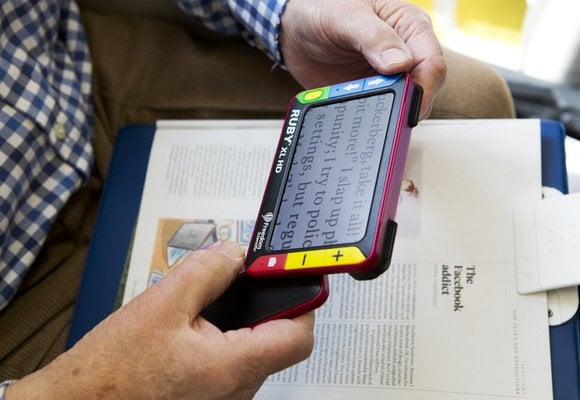These wearable devices are mainly for magnifying text and objects and enhancing remaining useful vision. They can all enhance both distance and near vision. These technologies change all the time and some may introduce speech options in future.
IrisVision Live headset magnifier
This consists of a Samsung VR Gear visor headset and a Samsung smartphone with IrisVision software. It magnifies whatever you look at through the visor, whether distant or near, and the image is shown in front of your eyes. IrisVision has a very wide field of view and for some people this can compensate for peripheral, or patchy, vision loss.
Watch the IrisVision in use on YouTube.
The IrisVision headset magnifier is supplied in the UK by VisionAid Technologies and you can find out more on it on their website.
Price £2,895 (VAT relief available).
VisionAid Technologies also supply eSight, Orcam MyEye and NuEyes (see below) and can demonstrate all its devices to customers at home and at exhibitions.
eSight 4
This is a visor style headset with a very modern design. It’s light, and comfortable to wear for long periods. eSight 4 has 24x zoom and can connect to a TV, computer or a games console.
Watch the eSight in use on YouTube or find out more about it from VisionAid Technologies.
Price: £6,995 (VAT relief available).
SightPlus
SightPlus is a headset that has been designed to enhance the vision of people with severe sight impairments. It combines the capabilities of a near-distance magnifier and long-distance telescope. It will help with stationary daily living activities such as watching TV, reading, following a play and working on screen-displays.
If you have sight conditions such as macular degeneration (AMD), Stargardt's, albinism or diabetic retinopathy and/or if you benefit from magnification tools in general, you could see an impact on your vision with the device.
The UK supplier is GiveVision. If you want to try SightPlus, contact 01216 30 30 63 or sign up here.
Free testing sessions are available in London, Birmingham and with their partners (opticians, charities and low vision aids retailers) in other locations.
Here are links to a couple of videos of SightPlus in use:







